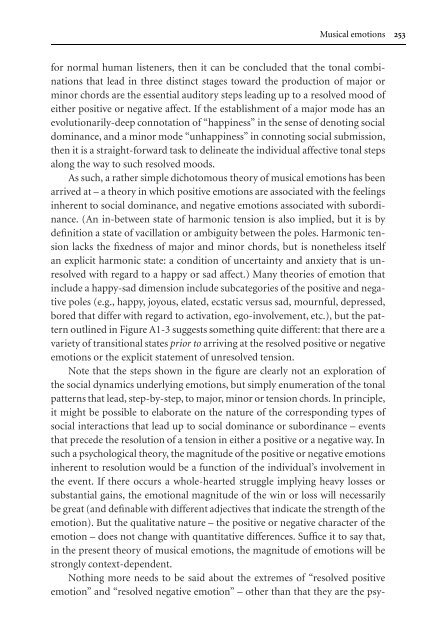Tone of Voice and Mind : The Connections between Intonation ...
Tone of Voice and Mind : The Connections between Intonation ...
Tone of Voice and Mind : The Connections between Intonation ...
Create successful ePaper yourself
Turn your PDF publications into a flip-book with our unique Google optimized e-Paper software.
Musical emotions 253<br />
for normal human listeners, then it can be concluded that the tonal combinations<br />
that lead in three distinct stages toward the production <strong>of</strong> major or<br />
minor chords are the essential auditory steps leading up to a resolved mood <strong>of</strong><br />
either positive or negative affect. If the establishment <strong>of</strong> a major mode has an<br />
evolutionarily-deep connotation <strong>of</strong> “happiness” in the sense <strong>of</strong> denoting social<br />
dominance, <strong>and</strong> a minor mode “unhappiness” in connoting social submission,<br />
then it is a straight-forward task to delineate the individual affective tonal steps<br />
along the way to such resolved moods.<br />
As such, a rather simple dichotomous theory <strong>of</strong> musical emotions has been<br />
arrived at – a theory in which positive emotions are associated with the feelings<br />
inherent to social dominance, <strong>and</strong> negative emotions associated with subordinance.<br />
(An in-<strong>between</strong> state <strong>of</strong> harmonic tension is also implied, but it is by<br />
definition a state <strong>of</strong> vacillation or ambiguity <strong>between</strong> the poles. Harmonic tension<br />
lacks the fixedness <strong>of</strong> major <strong>and</strong> minor chords, but is nonetheless itself<br />
an explicit harmonic state: a condition <strong>of</strong> uncertainty <strong>and</strong> anxiety that is unresolved<br />
with regard to a happy or sad affect.) Many theories <strong>of</strong> emotion that<br />
include a happy-sad dimension include subcategories <strong>of</strong> the positive <strong>and</strong> negative<br />
poles (e.g., happy, joyous, elated, ecstatic versus sad, mournful, depressed,<br />
bored that differ with regard to activation, ego-involvement, etc.), but the pattern<br />
outlined in Figure A1-3 suggests something quite different: that there are a<br />
variety <strong>of</strong> transitional states prior to arriving at the resolved positive or negative<br />
emotions or the explicit statement <strong>of</strong> unresolved tension.<br />
Note that the steps shown in the figure are clearly not an exploration <strong>of</strong><br />
the social dynamics underlying emotions, but simply enumeration <strong>of</strong> the tonal<br />
patterns that lead, step-by-step, to major, minor or tension chords. In principle,<br />
it might be possible to elaborate on the nature <strong>of</strong> the corresponding types <strong>of</strong><br />
social interactions that lead up to social dominance or subordinance – events<br />
that precede the resolution <strong>of</strong> a tension in either a positive or a negative way. In<br />
such a psychological theory, the magnitude <strong>of</strong> the positive or negative emotions<br />
inherent to resolution would be a function <strong>of</strong> the individual’s involvementin<br />
the event. If there occurs a whole-hearted struggle implying heavy losses or<br />
substantial gains, the emotional magnitude <strong>of</strong> the win or loss will necessarily<br />
be great (<strong>and</strong> definable with different adjectives that indicate the strength <strong>of</strong> the<br />
emotion). But the qualitative nature – thepositiveornegativecharacter<strong>of</strong>the<br />
emotion – does not change with quantitative differences. Suffice it to say that,<br />
in the present theory <strong>of</strong> musical emotions, the magnitude <strong>of</strong> emotions will be<br />
strongly context-dependent.<br />
Nothing more needs to be said about the extremes <strong>of</strong> “resolved positive<br />
emotion” <strong>and</strong> “resolved negative emotion” –other than that they are the psy-


